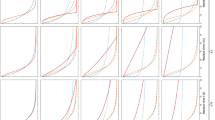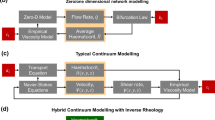Abstract
To mathematically model multiple indicator dilution (MID) data for the purpose of estimating parameters descriptive of indicator-tissue interactions, it is necessary to account for the effects of the distribution of capillary transit times, hc(t) In this paper, we present an efficient approach for incorporating hc(t) in the mathematical modeling of MID data. In this method, the solution of the model partial differential equations obtained at different locations along the model capillary having the longest transit time provides the outflow concentrations for all capillaries. When weighted by hc(t) these capillary outflow concentrations provide the outflow concentration versus time curve for the capillary bed. The method is appropriate whether the available data on capillary dispersion are in terms of capillary transit time or relative flow distributions, and whether the dispersion results from convection time differences among heterogeneous parallel pathways or axial diffusion along individual pathways. Finally, we show that the knowledge of a relationship among the moments of hc(t) rather than hc(t) per se, is sufficient information to account for the effect of hc(t) in the mathematical modeling interpretation of MID data. This relationship can be determined by including a flow-limited indicator in the injected bolus, thus providing an efficient means for obtaining the experimental data sufficient to account for capillary flow and transit time heterogeneity in MID modeling. © 1998 Biomedical Engineering Society.
PAC98: 8745Ft, 8710+e, 0230Jr
Similar content being viewed by others
REFERENCES
Abounader, R., J. Vogel, and W. Kuschinsky. Patterns of capillary plasma perfusion in brains of conscious rats during normocapnia and hypercapnia. Circ. Res.76:120-126, 1995.
Audi, S. H., C. A. Dawson, J. H. Linehan, G. S. Krenz, S. B. Ahlf, and D. L. Roerig. An interpretation of 14C-urea and 14C-primidone extraction in isolated rabbit lungs. Ann. Biomed. Eng.24:337-351, 1996.
Audi, S. H., C. A. Dawson, J. H. Linehan, G. S. Krenz, S. B. Ahlf, and D. L. Roerig. Pulmonary disposition of lipophilic amine compounds in the isolated perfused rabbit lung. J. Appl. Physiol.84:516-530, 1998.
Audi, S. H., G. S. Krenz, J. H. Linehan, D. A. Rickaby, and C. A. Dawson. Pulmonary capillary transport function from flow-limited indicators. J. Appl. Physiol.77:332-351, 1994.
Audi, S. H., J. H. Linehan, G. S. Krenz, C. A. Dawson, S. B. Ahlf, and D. L. Roerig. Estimation of the pulmonary transport function in isolated rabbit lungs. J. Appl. Physiol.78:1004-1014, 1995.
Bassingthwaighte, J. B., and C. A. Goresky. Modeling in the analysis of solute and water exchange in the microvasculature. In: Handbook of Physiology, edited by E. M. Renkin and C. C. Michel. Bethesda, MD: American Physiology Society 1984, Sec. 2, Vol. IV, Part 1, pp. 549-626.
Bassinthwaighte, J. B., M. A. Malone, T. C. Moffett, R. B. King, S. E. Little, J. M. Link, and K. A. Krohn. Validity of microsphere depositions for regional myocardial flows. Am. J. Physiol.253:H184-H193, 1987.
Bassingthwaighte, J. B., and M. Levin. Analysis of coronary outflow dilution curves for the estimation of cellular uptake rates in the presence of heterogeneous regional flows. Basic Res. Cardiol.76:404-410, 1981.
Bird, R. B., W. E. Stewart, and E. N. Lightfoot. In: Transport Phenomena. New York: Wiley, 1962, pp. 495-520.
Bronikowski, T. A., C. A. Dawson, and J. H. Linehan. On indicator dilution and perfusion heterogeneity: a stochastic model. Math. Biosci.83:199-225, 1987.
Capen, R. L., W. L. Hanson, L. P. Latham, C. A. Dawson, and W. W. Wagner, Jr. Distribution of pulmonary capillary transit times in recruited networks. J. Appl. Physiol.69:473- 478, 1990.
Capen, R. L., L. P. Latham, and W. W. Wagner, Jr. Comparison of direct and indirect measurements of pulmonary capillary transit times. J. Appl. Physiol.62:1150-1154, 1987.
Dawson, C. A., D. L. Roerig, and J. H. Linehan. Evaluation of endothelial injury in the human lung. In: Clinics in Chest Medicine, edited by S. G. Jenkinson. Philadelphia: Saunders, 1989, Vol. 10.
Dawson, C. A., D. L. Roerig, D. A. Rickaby, L. D. Nelin, J. H. Linehan, and G. S. Krenz. Use of diazepam for interpreting changes in extravascular lung water. J. Appl. Physiol.72:686-693, 1992.
Finlayson, B. A. In: Numerical Methods for Problems With Moving Fronts. Seattle: Ravena, 1992.
Fung, Y. C., and S. S. Sobin. Pulmonary alveolar blood flow. Circ. Res.30:470-490, 1972.
Glenny, R. W., and H. T. Robertson. Fractal modeling of pulmonary blood flow heterogeneity. J. Appl. Physiol.70:1024-1030, 1991.
Goresky, C. A. A linear method for determining liver sinusoidal and extravascular volumes. Am. J. Physiol.204:626- 640, 1963.
Goresky, C. A., W. H. Ziegler, and G. G. Bach. Capillary exchange modeling. Circ. Res.27:739-764, 1970.
Goresky, C. A., and C. P. Rose. Blood-tissue exchange in liver and heart: the influence of capillary transit times. Fed. Proc.36:2629-2634, 1977.
Harris, T. R., K. C. Brigham, and R. D. Rowlett. Pressure, serotonin, and histamine effects on lung multiple-indicator curves in sheep. J. Appl. Physiol.: Respir., Environ. Exercise Physiol.44:245-253, 1978.
Harris, T. R., R. J. Roselli, C. R. Mauner, R. E. Parker, and N. A. Pou. Comparison of labeled propranediol and urea as markers of lung vascular injury. J. Appl. Physiol.62:1852- 1859, 1987.
Harris, T. R., and E. V. Newman. An analysis of mathematical models of circulatory indicator-dilution curves. J. Appl. Physiol.28:840-850, 1970.
Harris, T. R., C. M. Waters, and F. R. Haselton. Use of scaling theory to relate measurements of lung endothelial barrier permeability. J. Appl. Physiol.77:2496-2505, 1994.
King, R. B., J. B. Bassingthwaighte, J. R. S. Hales, and L. B. Rowell. Stability of heterogeneity of myocardial blood flow in normal awake baboons. Circ. Res.57:285-295, 1985.
King, R. B., G. M. Raymond, and J. B. Bassingthwaighte. Modeling blood flow heterogeneity. Ann. Biomed. Eng.24:352-372, 1996.
Linehan, J. H., T. A. Bronikowski, and C. A. Dawson. Kinetics of uptake and metabolism by endothelial cells from indicator dilution data. Ann. Biomed. Eng.15:201-215, 1987.
Sangren, W. C., and C. W. Sheppard. Mathematical derivation of the exchange of a labeled substance between a liquid flowing in a vessel and an external compartment. Bull. Math. Biophys.15:387-394, 1953.
Yipintsoi, T., W. A. Dobbs, Jr., P. D. Sanlon, T. J. Knopp, and J. B. Bassingthwaighte. Regional distribution of diffusible tracers and carbonized microspheres in the left ventricle of isolated dog hearts. Circ. Res.33:573-587, 1973.
Author information
Authors and Affiliations
Rights and permissions
About this article
Cite this article
Audi, S.H., Linehan, J.H., Krenz, G.S. et al. Accounting for the Heterogeneity of Capillary Transit Times in Modeling Multiple Indicator Dilution Data. Annals of Biomedical Engineering 26, 914–930 (1998). https://doi.org/10.1114/1.138
Issue Date:
DOI: https://doi.org/10.1114/1.138




